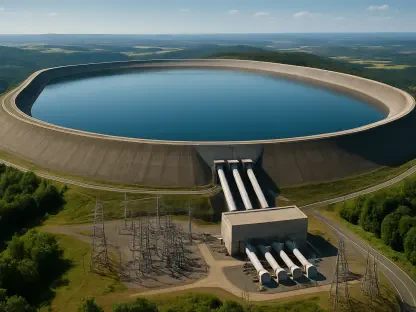The article focuses on the InterSCADA open-source control system’s development and deployment to address the evolving challenges within the European electricity supply system. It highlights the goals, capabilities, and intended benefits of the InterSCADA project, emphasizing its potential impact on grid operators across Europe amidst the ongoing energy transition. As the European energy landscape shifts towards decentralized power generation and increased integration of renewable energy sources, managing the stability of the power grid has become a critical issue that necessitates advanced control systems.
Addressing Modern Grid Challenges
The Need for Advanced Control Systems
As the European energy sector continues its transformation towards decentralized power generation, the incorporation of renewable energy sources into both AC and DC lines has resulted in increasingly complex hybrid power grids. This shift underscores the heightened need for advanced control systems capable of managing dynamic and decentralized power generation. Traditional SCADA systems, while historically valuable for grid monitoring and control, now require significant advancements to cope with the new challenges posed by hybrid power grids comprising renewable energy components like wind and solar. The complexity of these grids calls for improved data acquisition, smarter control algorithms, and more robust automation mechanisms, all aimed at ensuring grid stability and reliability.
The integration of renewable energy sources, often through advanced power electronics, underscores the need for SCADA platforms that can manage fluctuating power inputs. Unlike conventional power plants, renewable sources generate power variably, contributing to the dynamic nature of modern grids. This variability highlights the importance of a SCADA system capable of real-time data processing and proactive grid management. By enhancing the capabilities of SCADA systems to handle both AC and DC components, the InterSCADA project seeks to provide a robust solution, facilitating effective control and stability in this new energy landscape.
Project Goals and Collaborations
The primary goal of the InterSCADA project is to develop and test a vendor-independent SCADA platform that enables grid operators to rapidly and efficiently respond to sudden disruptions in hybrid AC/DC networks. This ambitious initiative is funded by the European Union and involves collaboration among 17 partners, a diverse group ranging from research institutions to industrial stakeholders. By leveraging innovative monitoring techniques, advanced control functions, and state-of-the-art automation mechanisms, InterSCADA aims to significantly enhance the stability and reliability of European power grids, ensuring uninterrupted power supply and operational efficiency.
The collaborative nature of the InterSCADA project plays a critical role in its success. Involving a wide array of stakeholders ensures that the platform not only addresses technical challenges but also meets practical needs and regulatory requirements. Collaboration among industry experts and researchers fosters an environment for innovative solutions, allowing the development of a SCADA platform that is both effective and adaptable to different scenarios. This coordinated effort forms the cornerstone of the project’s objective to create a seamless and resilient SCADA system, paving the way for a more stable and reliable power grid across Europe.
Innovations in SCADA Technology
Modular and Open-Source Approach
SCADA technology has evolved, with recent advancements focusing on modular open-source approaches to make these systems more adaptable and cost-effective. In this context, InterSCADA makes a notable contribution by developing new algorithms and software modules specifically designed to manage the complexities inherent in hybrid AC/DC grids. The modular design philosophy of InterSCADA ensures that grid operators can select and deploy only the necessary components, making the system both scalable and customizable. This adaptability is crucial for addressing the diverse technical challenges posed by different segments of the power grid, ensuring that the system remains efficient and cost-effective.
The open-source nature of the InterSCADA platform offers multiple advantages, including transparency, cost savings, and the potential for widespread adoption. By making the software code available to the public, InterSCADA encourages continuous improvements and innovations from the global community of developers and researchers. This collaborative and inclusive approach not only accelerates the development of new features but also ensures that the platform remains at the cutting edge of technology. Furthermore, the open-source model significantly reduces costs associated with proprietary systems, making advanced SCADA capabilities accessible to a broader range of grid operators.
Capabilities and Tasks
The InterSCADA platform is designed to perform a wide range of tasks, including collecting and analyzing grid status information, assessing line capacity utilization, localizing and addressing faults at different voltage levels, and facilitating communication among various electrical devices such as switches and protection units. One of the standout features of the platform is its ability to provide real-time information on the grid’s status, enabling operators to make informed decisions quickly. This real-time capability is essential for identifying potential issues before they escalate, ensuring proactive maintenance and rapid response to disruptions.
Another significant task that the InterSCADA platform undertakes is the assessment of line capacity utilization. By continuously monitoring the utilization levels of grid lines, the system can optimize power flow and prevent overloads, which could otherwise lead to failures or inefficiencies. The platform’s fault localization capabilities are equally critical, allowing operators to pinpoint and address problems at various voltage levels, enhancing the overall reliability of the power grid. Furthermore, by facilitating seamless communication among diverse electrical devices, InterSCADA ensures a coordinated and efficient response to dynamic grid conditions, thereby maintaining stability and operational integrity.
Environmental and Regulatory Considerations
Commitment to Reducing Carbon Emissions
One of the key drivers of the InterSCADA project is the European energy sector’s unwavering commitment to reducing carbon emissions and decreasing dependency on imported energy. The integration of renewable energy sources like wind and solar into the grid is a cornerstone of this commitment, aimed at fostering a cleaner, more sustainable energy infrastructure. Advanced control systems like InterSCADA are instrumental in this transition, as they enable the effective management of renewable energy inputs, ensuring that they are utilized optimally and sustainably. By providing enhanced monitoring and control capabilities, InterSCADA supports the seamless integration of renewable sources, thereby contributing to the reduction of carbon footprints across Europe.
The move towards clean energy is not only environmentally beneficial but also economically advantageous. By decreasing reliance on imported fossil fuels, European nations can achieve greater energy independence and stability. This shift also accelerates innovation and job creation within the renewable energy sector, driving economic growth while supporting environmental goals. The role of SCADA systems like InterSCADA in this process is pivotal, as they provide the necessary infrastructure to manage and optimize the new energy landscape. As Europe continues to progress towards its ambitious climate targets, the importance of advanced control systems in sustaining these efforts cannot be overstated.
Testing Across Europe
InterSCADA’s open-source nature and modular design make it particularly well-suited for addressing the diverse technical and regulatory conditions across Europe. The project includes testing the platform in demonstrators across four European countries: France, Greece, Italy, and Spain, to verify its effectiveness under various regulatory frameworks. These tests are crucial for ensuring that the platform can be effectively implemented in different geographic locations, considering unique local conditions and various types of grid infrastructure. The insights gained from these tests will be invaluable for refining and optimizing the platform, ensuring that it meets the stringent demands of real-world operations.
Testing the platform across multiple countries also highlights the cross-border applicability and flexibility of InterSCADA. Each participating country brings its regulatory environments and grid conditions, providing a comprehensive testing ground for the platform. These diverse scenarios present both challenges and opportunities for the InterSCADA team, allowing them to tailor solutions that address specific needs while maintaining general applicability. Successful demonstrations across these varied conditions will not only validate the platform’s capabilities but also build confidence among potential users, paving the way for wider adoption and implementation.
The Future of Power Grid Management
Enhancing Grid Stability
The modular SCADA platform represents a vital innovation for the future of power grid management in Europe. By fostering greater flexibility, interoperability, and resilience, InterSCADA is positioned to play a pivotal role in the ongoing energy transition. Its advanced features and adaptability make it an indispensable tool for grid operators tasked with managing increasingly complex and dynamic power systems. Enhancing grid stability is one of the primary outcomes of this innovative platform, as it enables operators to respond swiftly to disruptions, optimize power flow, and maintain the overall integrity of the grid.
The importance of grid stability cannot be overstated, particularly as Europe continues to integrate more renewable energy sources into its electricity supply. These sources, while environmentally beneficial, introduce a level of variability and uncertainty that traditional power systems were not designed to handle. InterSCADA addresses this challenge by providing a robust and adaptive control framework that can manage the unique demands of hybrid AC/DC grids. By ensuring consistent and reliable power delivery, even amid fluctuations, the platform supports the broader goals of a sustainable and resilient energy system.
Supporting Broader Energy Goals
The article discusses the development and deployment of the InterSCADA open-source control system, designed to tackle the changing challenges within the European electricity supply system. It showcases the objectives, functions, and anticipated advantages of the InterSCADA project, underscoring its potential impact on grid operators throughout Europe during the ongoing energy transition. As Europe moves towards decentralized power generation and greater integration of renewable energy sources, it becomes increasingly crucial to manage the power grid’s stability. This has created a pressing need for sophisticated control systems like InterSCADA. The project aims to provide grid operators with advanced tools to ensure grid stability, optimize operations, and facilitate the integration of renewable energies. By doing so, InterSCADA could play a pivotal role in transforming Europe’s energy landscape, making it more resilient, efficient, and sustainable in the face of evolving energy demands and environmental goals.









